If you’re looking for a colorful and easy-to-care-for fish, the Glowlight Tetra might be the perfect addition to your aquarium. These small, vibrant fish are native to South America and are popular among fish keepers for their striking appearance and peaceful temperament. In this article, I’ll share everything you need to know about caring for Glowlight Tetras, from their ideal tank conditions to their diet and breeding habits.
Glowlight tetras require a well-maintained aquarium with suitable water conditions, a varied diet, and a peaceful environment. They need a pH range of 6.0-7.8 and a temperature range between 72-82°F. The aquarium should be planted, and regular water changes should be performed to ensure their health. They are peaceful and social fish, making them an excellent choice for community tanks.
As an avid fish keeper myself, I know firsthand how important it is to provide the best possible care for your aquatic pets. That’s why I’m excited to share my knowledge and experience with you, so you can give your Glowlight Tetras the best life possible. Whether you’re a beginner or an experienced fish keeper, this article will provide you with all the information you need to keep your Glowlight Tetras healthy and happy.
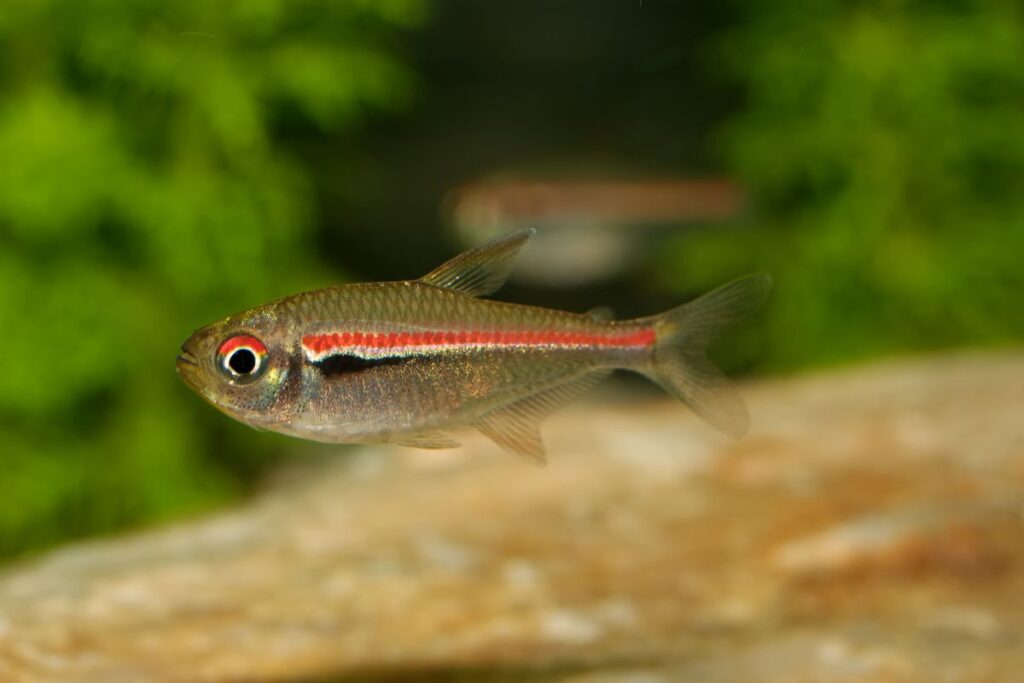
Table of Contents
Species Summary
Glowlight Tetras are a popular freshwater fish among aquarium enthusiasts. They are known for their vibrant colors and peaceful nature, making them a great addition to any community tank.
In this section, we will cover everything you need to know about caring for Glowlight Tetras, including their origin, lifespan, appearance, size, growth rate, behavior & temperament, and male vs female differences.
Origin
Glowlight Tetras are native to the Amazon River basin in South America, specifically in the countries of Brazil, Colombia, and Peru.
They can also be found in other parts of the world due to their popularity in the aquarium trade.
Lifespan
The average lifespan of a Glowlight Tetra is around 3-5 years. With proper care, some individuals have been known to live up to 7 years.
Appearance
Glowlight Tetras are small fish, typically growing to a maximum size of 1.5 inches.
They have a bright orange-red stripe along their body, which contrasts with their silver body and black dorsal fin.
Their fins are translucent, giving them a delicate and graceful appearance.
Size
As previously mentioned, Glowlight Tetras typically grow to a maximum size of 1.5 inches.
They are a small fish and can be kept in small to medium-sized aquariums.
Growth Rate
The growth rate of Glowlight Tetras is relatively slow compared to other fish species. It can take up to a year for them to reach their maximum size.
It is important to note that their growth rate can be affected by factors such as water quality and diet.
Behavior & Temperament
Glowlight Tetras are peaceful and social fish, making them great community tank inhabitants.
They are known for their playful and active nature, often seen swimming around and exploring their environment.
They are also known to be timid and may hide if they feel threatened or stressed.
Male vs Female
Male and female Glowlight Tetras are difficult to distinguish.
However, during breeding season, females may appear slightly rounder due to the eggs they carry.
Personally, I have found that Glowlight Tetras are a joy to watch in my own aquarium.
Their vibrant colors and playful behavior make them a great addition to any tank.
With proper care, they can live a long and healthy life, bringing beauty and entertainment to your aquatic world.
Setting up a Tank
Tank Size
When setting up a tank for Glowlight Tetras, it is important to consider the size of the tank.
A minimum of 10 gallons is recommended for a small school of tetras, but a larger tank is always better.
I personally prefer a 20-gallon tank for my Glowlight Tetras, as it allows them more space to swim and explore.
Lighting
Proper lighting is crucial for the health and well-being of your Glowlight Tetras. They require a well-lit tank with a light spectrum that mimics natural sunlight.
A good rule of thumb is to provide 1-2 watts of light per gallon of water.
I use a full-spectrum LED light for my Glowlight Tetras, which provides the perfect amount of light for their needs.
Filtration and Aeration
Good filtration and aeration are essential for maintaining a healthy tank environment for your Glowlight Tetras.
A hang-on-back filter is a great option for a small tank, while a canister filter is better for larger tanks. In addition to filtration, aeration is important for maintaining oxygen levels in the water.
I use an air stone to provide a gentle flow of bubbles in my tank.
Heater
Glowlight Tetras are tropical fish and require a consistent water temperature of 75-82°F. A reliable heater is necessary to maintain the proper temperature in your tank.
I use a submersible heater with a built-in thermostat to keep my tank at a constant temperature.
Substrate
When choosing a substrate for your tank, it is important to consider the needs of your Glowlight Tetras. They prefer a soft substrate, such as sand or fine gravel, that won’t damage their delicate fins.
I use black sand in my tank, which not only looks great but also provides a natural environment for my tetras.
Aquarium Decor
Aquarium decor not only adds visual interest to your tank but also provides hiding places and shelter for your Glowlight Tetras.
I like to use natural-looking decorations, such as driftwood and rocks, to create a peaceful and natural environment for my tetras.
Plants
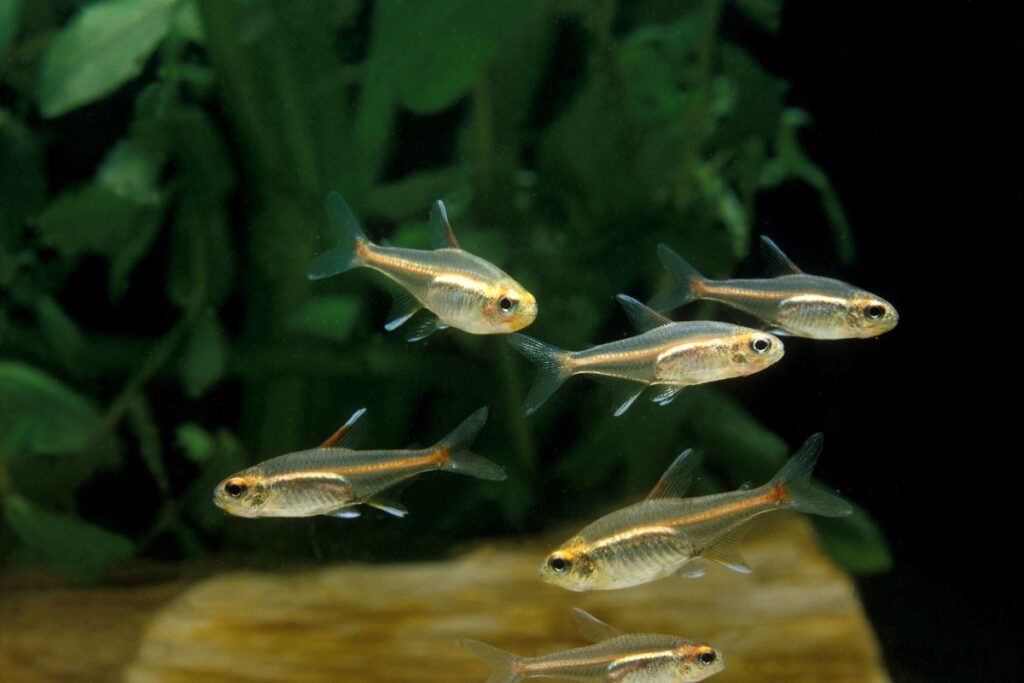
Live plants are a great addition to any tank and provide many benefits for your Glowlight Tetras.
They help to maintain water quality by absorbing nitrates and provide a natural food source for your tetras.
I like to use easy-to-care-for plants, such as Java Fern and Anubias, in my tank.
Overall, setting up a tank for Glowlight Tetras requires careful consideration of their needs and preferences.
By providing the right environment, you can ensure that your tetras thrive and live a long and healthy life.
Water Conditions
Proper water conditions are essential for the health and well-being of your Glowlight Tetras. Here are the key factors to keep in mind:
Water Temperature
The ideal temperature range for Glowlight Tetras is between 75-82°F (24-28°C).
I have found that keeping the temperature at around 78°F (26°C) works well for my tetras.
It’s important to keep the temperature stable, as sudden fluctuations can stress your fish and make them more susceptible to disease.
Water pH
Glowlight Tetras prefer slightly acidic to neutral water, with a pH range of 6.0-7.5. I have found that a pH of around 6.8-7.0 is ideal for my tetras.
Keep in mind that sudden changes in pH can be harmful to your fish, so it’s important to monitor the pH regularly and make gradual adjustments if necessary.
Water Hardness
Glowlight Tetras prefer soft to moderately hard water, with a hardness range of 5-12 dGH. I have found that a hardness of around 8 dGH works well for my tetras.
Keep in mind that some tetras may be more sensitive to water hardness than others, so it’s important to monitor your fish and make adjustments as needed.
Water Changes
Regular water changes are essential for maintaining good water quality and keeping your tetras healthy. I recommend changing 25-50% of the water in your aquarium every 1-2 weeks.
When performing water changes, be sure to use a water conditioner to remove chlorine and other harmful chemicals from your tap water.
Overall, maintaining proper water conditions is key to keeping your Glowlight Tetras healthy and happy.
By monitoring the temperature, pH, hardness, and performing regular water changes, you can create a comfortable and safe environment for your fish to thrive in.
Personally, I have found that my Glowlight Tetras are much more active and vibrant when the water conditions are just right.
It’s a great feeling to see them swimming around and exploring their environment with such enthusiasm!
Tank Mates for Glowlight Tetra
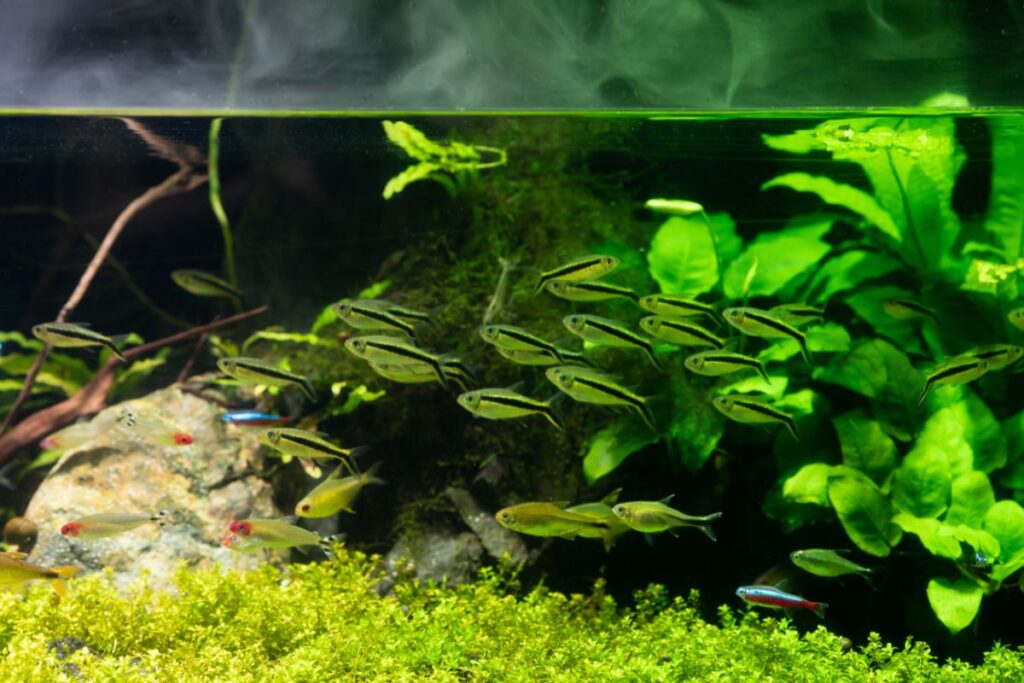
When it comes to selecting tank mates for your Glowlight Tetras, it is important to choose fish that are peaceful and compatible with their gentle nature.
Here are a few options that I have found to work well in my own experience:
- Neon Tetras: These fish have similar water and temperature requirements as Glowlight Tetras and are known for their peaceful nature.
- Cherry Barbs: These fish are colorful and active, but also peaceful and not likely to bother your Glowlight Tetras.
- Corydoras Catfish: These bottom-dwelling fish are a great addition to any community tank and won’t compete with your Glowlight Tetras for food.
It is important to note that some fish should be avoided as tank mates for Glowlight Tetras. Avoid any fish that are aggressive or may nip at the fins of your tetras. Some examples of fish to avoid include:
- Betta Fish: These fish are known for their aggressive behavior and should not be kept with Glowlight Tetras.
- Cichlids: These fish are also known for their aggressive behavior and should not be kept with smaller, peaceful fish like Glowlight Tetras.
Overall, when selecting tank mates for your Glowlight Tetras, it is important to consider their peaceful nature and avoid any aggressive fish that may cause harm.
By choosing compatible tank mates, you can create a beautiful and harmonious community tank that everyone can enjoy.
Personally, I have found that adding a school of Neon Tetras to my Glowlight Tetra tank has been a great addition. The two species swim together peacefully and create a beautiful display of color and movement in my tank.
How Many Glowlight Tetras Should Be Kept Together?

When it comes to keeping glowlight tetras, it’s important to consider how many you should keep together in one tank.
As a general rule of thumb, it’s recommended to keep a minimum of 6 glowlight tetras together. This is because they are social fish and thrive in groups.
Personally, I have found that keeping a larger group of glowlight tetras together is even better. I have a group of 12 in my tank and they seem to be very happy and active.
However, it’s important to make sure that your tank is large enough to accommodate a larger group.
When deciding on how many glowlight tetras to keep together, it’s important to consider the size of your tank.
A 20-gallon tank can comfortably hold a group of 6-8 glowlight tetras. If you have a larger tank, you can keep a larger group of glowlight tetras.
It’s also important to consider the other fish in your tank. Glowlight tetras are peaceful fish and should be kept with other peaceful species.
Avoid keeping them with aggressive fish or fish that are much larger than them.
Overall, keeping a group of glowlight tetras together is the best way to ensure their happiness and well-being. Just make sure to provide them with a suitable environment and compatible tank mates.
Feeding
Diet
I have found that Glowlight Tetras thrive on a varied diet that includes both flakes and live foods.
In the wild, they feed on small insects and crustaceans, so it’s important to provide them with a similar diet in captivity.
High-quality flake foods, such as those made with spirulina and other plant-based ingredients, are a good staple food for Glowlight Tetras.
In addition to flakes, I like to supplement their diet with live or frozen foods, such as brine shrimp, bloodworms, and daphnia.
These foods provide important nutrients and help to keep the fish healthy and active.
Frequency
I feed my Glowlight Tetras twice a day, once in the morning and once in the evening. This schedule seems to work well for them, but it’s important to adjust the feeding frequency based on the needs of your specific fish.
If you notice that your fish are becoming overweight or underweight, you may need to adjust the amount or frequency of their feedings.
Amount
When it comes to feeding Glowlight Tetras, it’s important to avoid overfeeding. These fish have small stomachs and can easily become bloated if they eat too much.
I recommend feeding them only what they can consume in a few minutes, and removing any uneaten food from the tank after feeding.
A good rule of thumb is to feed your Glowlight Tetras an amount of food that is roughly equivalent to the size of their eye. This will ensure that they are getting enough to eat without overfeeding them.
Overall, a varied and balanced diet is key to keeping your Glowlight Tetras healthy and happy.
By providing them with a mix of high-quality flakes and live or frozen foods, and feeding them in moderation, you can help ensure that they thrive in your aquarium.
Health and Maintenance
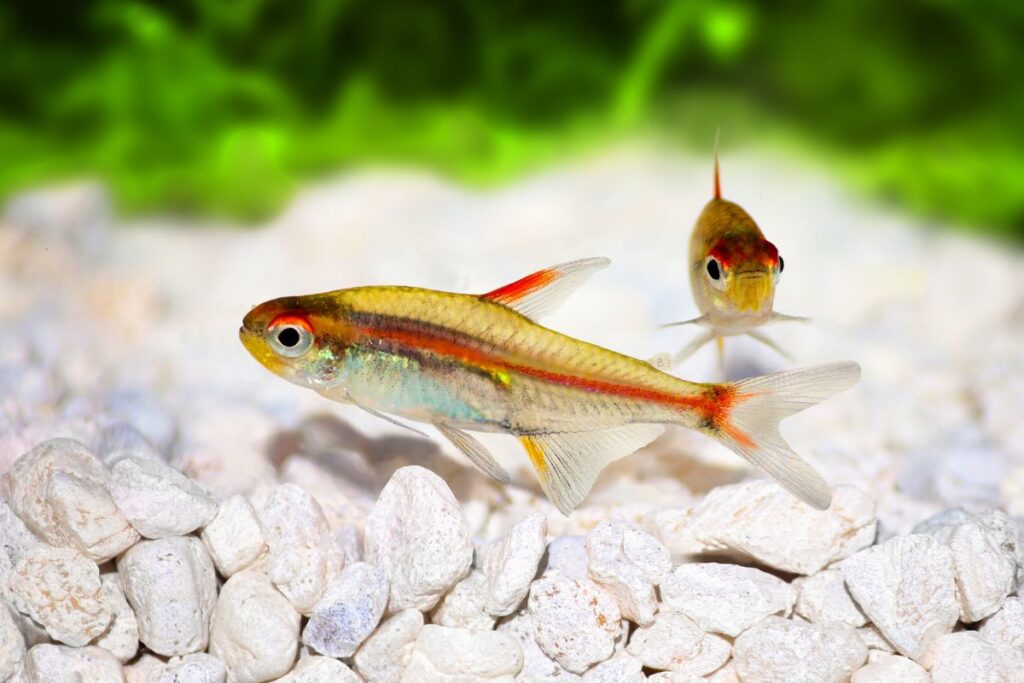
Common Diseases
As an aquarium owner, it’s important to be aware of the common diseases that can affect your Glowlight Tetras.
One of the most common diseases is ich, which is caused by a parasite and can be identified by white spots on the fish’s body.
Another common disease is fin rot, which can be caused by poor water quality or injury and can be identified by frayed or deteriorating fins.
I’ve personally dealt with both ich and fin rot in my own aquarium, and it’s important to act quickly to prevent the disease from spreading to other fish.
Quarantining the affected fish and treating them with medication can help prevent the spread of disease.
Treatment
If you suspect that your Glowlight Tetras are sick, it’s important to act quickly to prevent the disease from spreading.
There are a variety of medications available to treat common diseases like ich and fin rot.
Follow the instructions carefully and be sure to remove any activated carbon from your filter before adding medication to the aquarium.
It’s also important to maintain good water quality and perform regular water changes to prevent the spread of disease. Keeping the aquarium clean and well-maintained can go a long way in preventing illness in your fish.
Disease Prevention
The best way to prevent disease in your Glowlight Tetras is to maintain good water quality and keep the aquarium clean.
Perform regular water changes and test the water regularly to ensure that the levels of ammonia, nitrite, and nitrate are within safe levels.
Quarantining new fish before adding them to the aquarium can also help prevent the spread of disease. It’s important to observe new fish for any signs of illness before adding them to the main aquarium.
Cleaning and Maintenance
Regular cleaning and maintenance of the aquarium is crucial for the health of your Glowlight Tetras.
Perform weekly water changes of 25% to 50% to remove any excess waste and maintain good water quality.
Clean the aquarium glass, decorations, and filter regularly to prevent the buildup of algae and debris.
Be sure to use a gentle cleaner and rinse everything thoroughly before returning it to the aquarium.
By following these simple steps, you can help ensure the health and longevity of your Glowlight Tetras.
Signs of a Healthy Glowlight Tetra
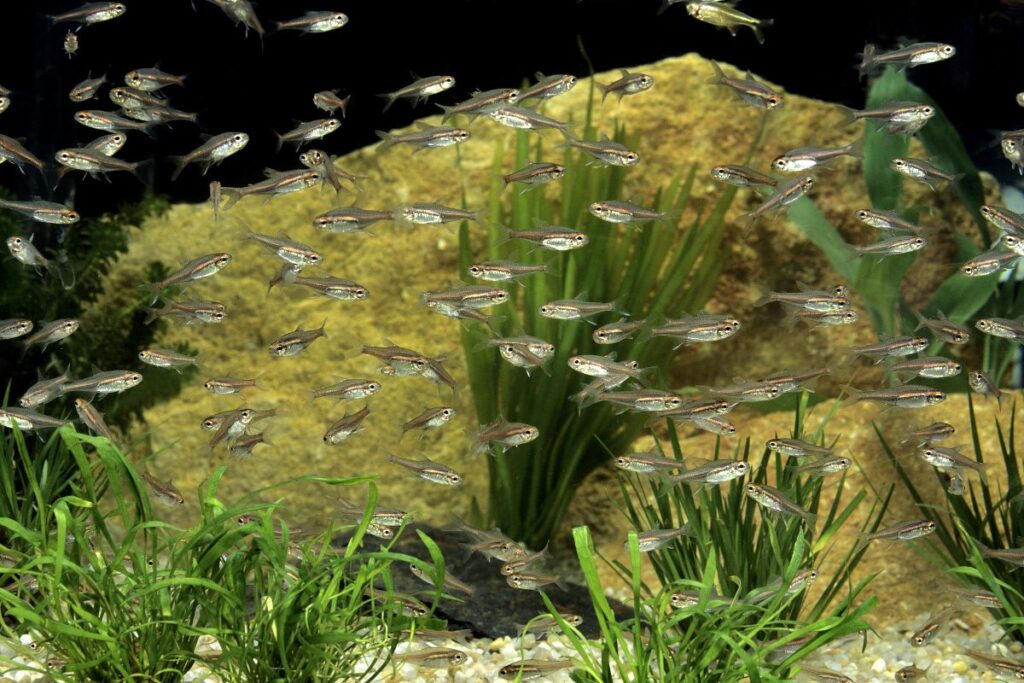
As an aquarium enthusiast, I know that keeping your fish healthy is a top priority. Here are some signs to look for to ensure your glowlight tetra is in good health:
- Active swimming: A healthy glowlight tetra will be active and swim around the tank.
- Clear eyes: The eyes of a healthy glowlight tetra will be clear and free of cloudiness or discoloration.
- Bright coloration: The orange and silver coloration of a glowlight tetra should be vibrant and bright. Faded colors can be a sign of poor health.
- Healthy fins: The fins of a healthy glowlight tetra should be intact and not torn or frayed.
- Normal breathing: A healthy glowlight tetra will breathe normally and not gasp for air at the surface of the water.
It’s important to note that even if your glowlight tetra is exhibiting all of these signs, regular check-ups with a veterinarian specializing in aquatic animals is recommended to ensure their continued health and well-being.
Personally, I always make sure to observe my glowlight tetras closely and keep track of their behavior and appearance.
It’s a great way to catch any potential health issues early on and ensure my fish are happy and healthy.
Signs of a Sick Glowlight Tetra
As a fish owner, it is important to keep an eye on your glowlight tetra’s behavior and appearance. Here are some signs that your glowlight tetra may be sick:
- Loss of appetite: If your glowlight tetra is not eating or appears to be eating less than usual, it may be a sign of illness.
- Unusual swimming behavior: If your glowlight tetra is swimming erratically, such as swimming upside down or sideways, it may be a sign of a swim bladder issue.
- Discoloration: If your glowlight tetra’s color appears faded or dull, it may be a sign of illness or stress.
- Clamped fins: If your glowlight tetra’s fins are clamped against its body, it may be a sign of stress or illness.
- Gasping for air: If your glowlight tetra is gasping for air at the surface of the water, it may be a sign of poor water quality or a lack of oxygen in the tank.
If you notice any of these signs in your glowlight tetra, it is important to take action quickly to address the issue.
It may be helpful to consult with a veterinarian or a fish expert to determine the best course of action.
I remember when my glowlight tetra started swimming upside down. I was worried and didn’t know what to do.
After consulting with a fish expert, I learned that it was likely a swim bladder issue and was able to take the necessary steps to help my fish recover.
It’s important to pay attention to your fish’s behavior and take action when necessary to ensure their health and wellbeing.
Breeding

Mating Behavior
Glowlight Tetras are egg scatterers and breed in groups. During mating, males will chase females around the aquarium and perform a courtship dance.
The female will lay her eggs, and the male will fertilize them. It’s important to have a good ratio of males to females to ensure successful breeding.
How to Know if a Glowlight Tetra is Pregnant
Unlike some other fish species, it can be difficult to tell if a glowlight tetra is pregnant.
However, if you notice a female has become rounder in the belly area, it’s possible she’s carrying eggs.
Females will also become more reclusive during this time and may hide in plants or decorations.
Breeding Tank Setup
If you’re planning to breed glowlight tetras, it’s recommended to set up a separate breeding tank.
The tank should be at least 10 gallons and have plenty of plants for the female to lay her eggs on. A sponge filter is a good choice for filtration as it won’t suck up any eggs or fry.
Egg Laying and Care
Once the female lays her eggs, it’s important to remove the adults from the breeding tank to prevent them from eating the eggs.
The eggs will hatch in about 24-36 hours, and the fry will become free-swimming a few days later. It’s important to keep the water clean and well-oxygenated during this time to ensure the fry’s survival.
Fry Care
When the fry are free-swimming, they can be fed infusoria or baby brine shrimp. As they grow, you can gradually increase the size of their food.
It’s important to keep up with regular water changes and monitor the water parameters closely to ensure the fry’s health. Within a few weeks, the fry will start to resemble adult glowlight tetras and can be moved to a larger tank.
Personally, I found breeding glowlight tetras to be a rewarding experience. It’s amazing to watch the whole process unfold, from the courtship dance to the hatching of the eggs. With a little patience and care, anyone can successfully breed these beautiful fish.
Recommended Products:
- Aqueon LED Aquarium Kit – This kit includes a 20-gallon tank with a full-spectrum LED light for proper lighting, as well as a filter and heater for filtration and aeration.
- Tetra Whisper Air Pump – This air pump provides additional aeration for your tank, which is important for maintaining oxygen levels in the water.
- Fluval Canister Filter – This canister filter is ideal for larger tanks and provides powerful filtration to keep the water clean and clear.
- Eheim Jager Aquarium Heater – This submersible heater with a built-in thermostat is reliable and easy to use, ensuring a consistent water temperature for your Glowlight Tetras.
- CaribSea Super Naturals Aquarium Sand – This soft sand substrate is ideal for Glowlight Tetras, as it won’t damage their delicate fins and provides a natural environment for them.
- Marina Decor Polyresin Cave – This aquarium decoration provides hiding places and shelter for your Glowlight Tetras, as well as adding visual interest to your tank.
- Java Fern – This easy-to-care-for live plant helps maintain water quality by absorbing nitrates and provides a natural food source for your tetras.
- API Freshwater Master Test Kit – This test kit allows you to monitor the temperature, pH, and water hardness of your tank, ensuring proper water conditions for your Glowlight Tetras.
- Seachem Prime – This water conditioner removes harmful chemicals from tap water during water changes, ensuring a safe and healthy environment for your fish.
- Hikari Micro Pellets – These high-quality micro pellets are a great staple food for Glowlight Tetras, providing important nutrients for their health and vitality.
Conclusion
After caring for Glowlight Tetras for several years, I can confidently say that they are a great addition to any aquarium. They are easy to care for, peaceful, and add a beautiful pop of color to any tank.
When it comes to their care, it’s important to provide them with a well-maintained tank, suitable tank mates, and a balanced diet. I’ve found that feeding them a combination of flakes, pellets, and frozen foods keeps them healthy and happy.
One thing to keep in mind is that Glowlight Tetras are sensitive to water conditions, so regular water changes and testing is a must. I recommend testing the water at least once a week and changing 25% of the water every other week.
Overall, I highly recommend Glowlight Tetras to anyone looking for a peaceful and colorful addition to their aquarium. With proper care, they can live for several years and provide endless enjoyment.
So if you’re thinking about adding some Glowlight Tetras to your tank, go for it! I promise you won’t regret it.
FAQs
As a proud owner of Glowlight Tetras, I have gathered some frequently asked questions that might help you in taking care of these beautiful fish.
How many Glowlight Tetras can I keep in my tank?
It is recommended to keep at least 6 Glowlight Tetras in a tank, as they are schooling fish and need to be in groups to feel safe and comfortable. However, make sure not to overcrowd the tank as it can lead to stress and health problems for your fish.
What should I feed my Glowlight Tetras?
Glowlight Tetras are omnivores, meaning they eat both plants and animals. You can feed them a variety of foods such as flakes, pellets, freeze-dried or live food such as bloodworms or brine shrimp. It is important to provide a balanced diet to keep them healthy and active.
How often should I clean my Glowlight Tetra tank?
It is recommended to clean your Glowlight Tetra tank once a week. You should replace 20-25% of the water and clean the gravel with a siphon. Make sure not to clean everything at once as it can disturb the beneficial bacteria in the tank that helps to keep the water clean.
Can I keep Glowlight Tetras with other fish?
Yes, Glowlight Tetras are peaceful fish and can be kept with other peaceful fish such as Neon Tetras, Guppies, and Corydoras. However, avoid keeping them with aggressive or larger fish as they can harm your Glowlight Tetras.
Overall, taking care of Glowlight Tetras is not difficult as long as you provide them with a suitable environment and a balanced diet. I hope these FAQs have helped you in taking care of your Glowlight Tetras.
Reference: Wikipedia.
